句子成分和简单句五个基本句型
- 格式:doc
- 大小:50.00 KB
- 文档页数:6
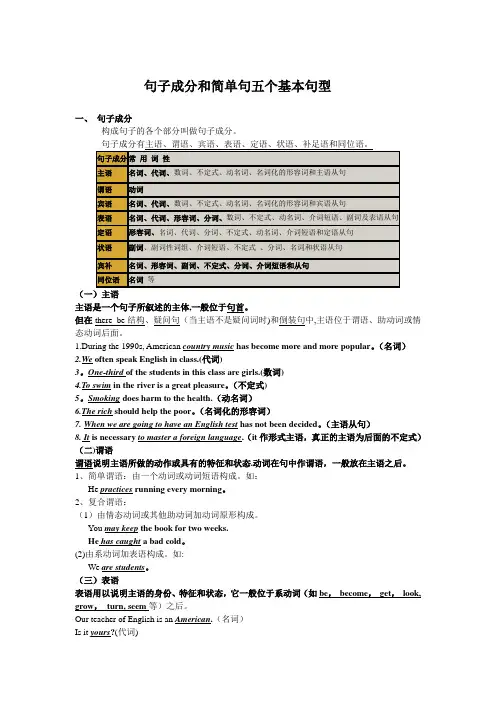
句子成分和简单句五个基本句型一、句子成分构成句子的各个部分叫做句子成分。
(一)主语主语是一个句子所叙述的主体,一般位于句首。
但在there be结构、疑问句(当主语不是疑问词时)和倒装句中,主语位于谓语、助动词或情态动词后面。
1.During the 1990s, American country music has become more and more popular。
(名词)2.We often speak English in class.(代词)3。
One-third of the students in this class are girls.(数词)4.To swim in the river is a great pleasure。
(不定式)5。
Smoking does harm to the health.(动名词)6.The rich should help the poor。
(名词化的形容词)7. When we are going to have an English test has not been decided。
(主语从句)8. It is necessary to master a foreign language.(it作形式主语,真正的主语为后面的不定式)(二)谓语谓语说明主语所做的动作或具有的特征和状态.动词在句中作谓语,一般放在主语之后。
1、简单谓语:由一个动词或动词短语构成。
如:He practices running every morning。
2、复合谓语:(1)由情态动词或其他助动词加动词原形构成。
You may keep the book for two weeks.He has caught a bad cold。
(2)由系动词加表语构成。
如:We are students。
(三)表语表语用以说明主语的身份、特征和状态,它一般位于系动词(如be,become,get,look, grow,turn, seem等)之后。

英语句子的成分及简单句的五种基本句式Ⅰ. ▲句子成分分类1.主语:主语是谓语讲述的对象,表示所说的“是什么”或“是谁”。
一般由名词、代词、不定代词或相当于名词的单词或短语来充当,也有从句充当的现象。
大多数主语都在句首。
如:We didn’t have enough time to think about problems by ourselves. We had to do muchhomework after class. She enjoys reading books and listening to music.Every coin has two sides(任何事物都有两面性)Three are enough.To spit in public is not polite. What to do next is not clear.Seeing English films is a good way to learn English well.Shopping on line has many advantages.What we need is food.▲在个别句型中,主语在整个句子后面,这时前面用it作形式主语。
如:It took two workers about three months to build the house.I t’s our duty to protect the environment.It’s very exciting not to have extra classes on holidays.It is important for us to obey traffic rules.On the other hand, there are some disadvantages to go online2.谓语:谓语时用来说明主语“做什么”、“是什么”或“怎么样”,谓语必须是动词,谓语和主语在“人称”和“数”两方面必须一致。

5种简单句基本句型及句子成分名词解释前五个句型属于简单句的基本句型,后面三个是中考中重要的简单句句型,最后面是句子成分的名词解释。
—一.五种简单句基本句型1.主语+谓语”即主谓”句型)这一句型英汉语言结构形式完全相同,说明某人或某物如何动作”,或者说某人或某物自身怎样运动”。
例:They arrived in Harbin yesterday morning.分析:“they主语)“ arrived谓语)。
2.主语+谓语+宾语”即主谓宾”句型)这一句型英汉语言的结构形式完全相同,用以说明某人或某物做什么事情”,或者说某人或某物发出了动作,并且其动作涉及到另一个人或物”。
例:I study English.分析:“ I主语)“study谓语动作)“ English宾语即动作涉及的对象)。
3.主语+谓语+间接宾语+直接宾语”即主谓双宾”句型)这一句型英汉语序结构相同,说明某人为谁(间接宾语为人)做某事”,或者说某人或物的运动涉及到两个对象,其中一个间接对象为人,另一个为物”。
例: Our teacher taught us English.分析:“our teacher主语)教”谓语动作)“us间接宾语)“English直接宾语)。
4.主语+谓语+宾语+宾语补足语”即主谓宾宾补”句型)这一句型说明某人或某物要求(使、让)某人做什么”或某人感觉某人或物怎么样”。
例:He asked her to go there.分析:“ he主语)asked谓语动作)“ her宾语即动作涉及的对象)“to go there 补”(语—补充说明宾语做什么)。
5.“主语+ 系动词+ 表语”即(“主系表”句型)这一句型用以说明“某人(某物、某事、某种概念)具有什么特征或处于什么状态”。
汉语的“是”字结构属于这一英语句型的形式之一。
常用的联系动词有be, keep ,lie, remain, stand, become, fall, get, go, grow, turn, look, feel, seem, smell, sound, taste, 等。

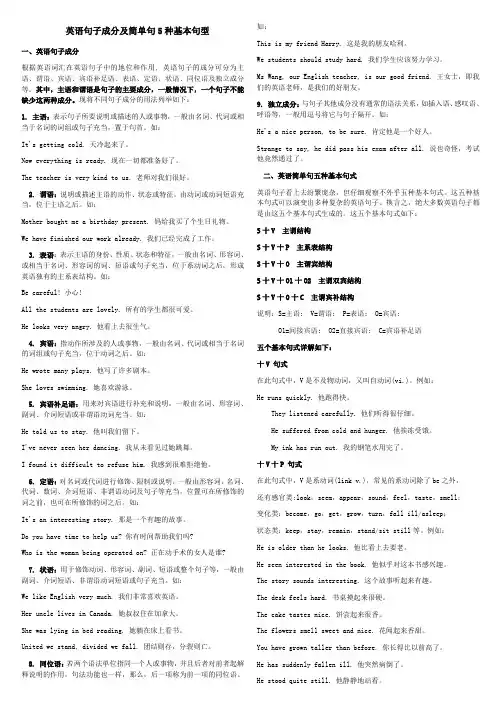
英语句子成分及简单句5种基本句型一、英语句子成分根据英语词汇在英语句子中的地位和作用, 英语句子的成分可分为主语、谓语、宾语、宾语补足语、表语、定语、状语、同位语及独立成分等。
其中,主语和谓语是句子的主要成分,一般情况下,一个句子不能缺少这两种成分。
现将不同句子成分的用法列举如下:1. 主语:表示句子所要说明或描述的人或事物,一般由名词、代词或相当于名词的词组或句子充当,置于句首。
如:It's getting cold. 天冷起来了。
Now everything is ready. 现在一切都准备好了。
The teacher is very kind to us. 老师对我们很好。
2. 谓语:说明或描述主语的动作、状态或特征,由动词或动词短语充当,位于主语之后。
如:Mother bought me a birthday present. 妈给我买了个生日礼物。
We have finished our work already. 我们已经完成了工作。
3. 表语:表示主语的身份、性质、状态和特征,一般由名词、形容词、或相当于名词、形容词的词、短语或句子充当,位于系动词之后,形成英语独有的主系表结构。
如:Be careful! 小心!All the students are lovely. 所有的学生都很可爱。
He looks very angry. 他看上去很生气。
4. 宾语:指动作所涉及的人或事物,一般由名词、代词或相当于名词的词组或句子充当,位于动词之后。
如:He wrote many plays. 他写了许多剧本。
She loves swimming. 她喜欢游泳。
5. 宾语补足语:用来对宾语进行补充和说明,一般由名词、形容词、副词、介词短语或非谓语动词充当。
如:He told us to stay. 他叫我们留下。
I've never seen her dancing. 我从未看见过她跳舞。
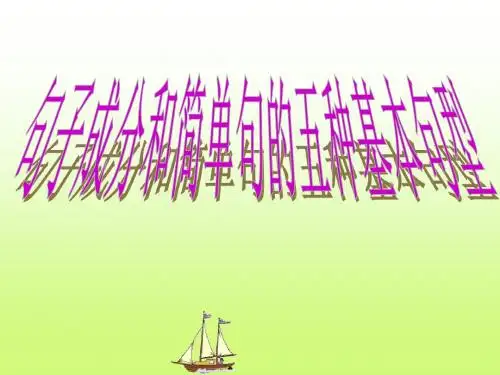
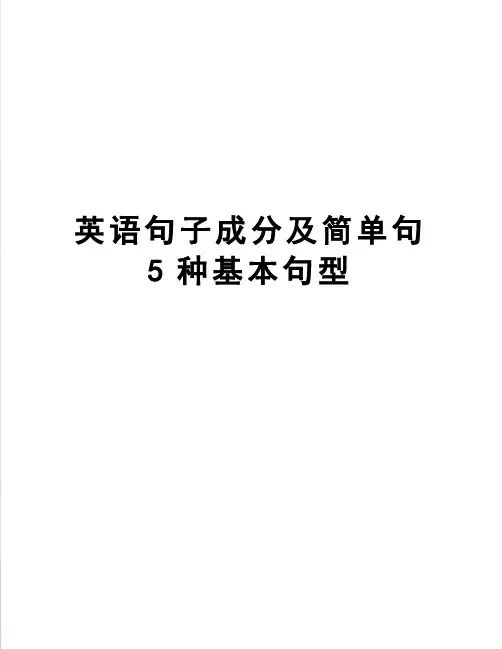
英语句子成分及简单句5种基本句型英语句子成分及简单句5种基本句型一、英语句子成分根据英语词汇在英语句子中的地位和作用, 英语句子的成分可分为主语、谓语、宾语、宾语补足语、表语、定语、状语、同位语及独立成分等。
其中,主语和谓语是句子的主要成分,一般情况下,一个句子不能缺少这两种成分。
现将不同句子成分的用法列举如下:1. 主语:表示句子所要说明或描述的人或事物,一般由名词、代词或相当于名词的词组或句子充当,置于句首。
如:It's getting cold. 天冷起来了。
Now everything is ready. 现在一切都准备好了。
The teacher is very kind to us. 老师对我们很好。
2. 谓语:说明或描述主语的动作、状态或特征,由动词或动词短语充当,位于主语之后。
如:Mother bought me a birthday present. 妈给我买了个生日礼物。
We have finished our work already. 我们已经完成了工作。
3. 表语:表示主语的身份、性质、状态和特征,一般由名词、形容词、或相当于名词、形容词的词、短语或句子充当,位于系动词之后,形成英语独有的主系表结构。
如:Be careful! 小心!All the students are lovely. 所有的学生都很可爱。
He looks very angry. 他看上去很生气。
4. 宾语:指动作所涉及的人或事物,一般由名词、代词或相当于名词的词组或句子充当,位于动词之后。
如:He wrote many plays. 他写了许多剧本。
She loves swimming. 她喜欢游泳。
5. 宾语补足语:用来对宾语进行补充和说明,一般由名词、形容词、副词、介词短语或非谓语动词充当。
如:He told us to stay. 他叫我们留下。
I've never seen her dancing. 我从未看见过她跳舞。
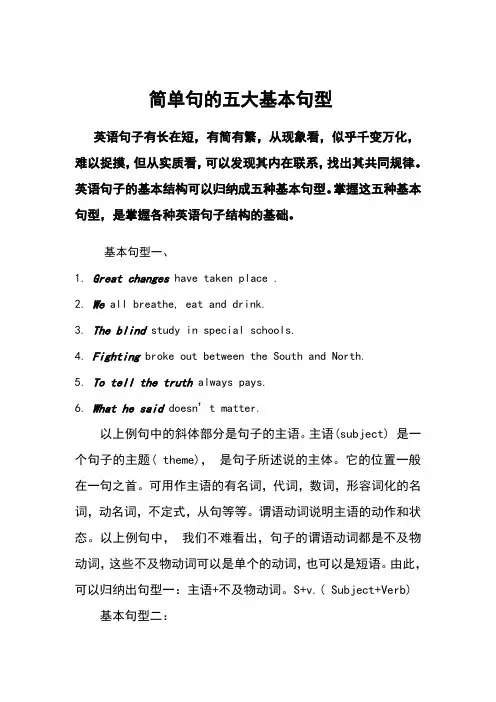
简单句的五大基本句型英语句子有长在短,有简有繁,从现象看,似乎千变万化,难以捉摸,但从实质看,可以发现其内在联系,找出其共同规律。
英语句子的基本结构可以归纳成五种基本句型。
掌握这五种基本句型,是掌握各种英语句子结构的基础。
基本句型一、1.Great changes have taken place .2.We all breathe, eat and drink.3.The blind study in special schools.4.Fighting broke out between the South and North.5.To tell the truth always pays.6.What he said doesn’t matter.以上例句中的斜体部分是句子的主语。
主语(subject) 是一个句子的主题( theme),是句子所述说的主体。
它的位置一般在一句之首。
可用作主语的有名词,代词,数词,形容词化的名词,动名词,不定式,从句等等。
谓语动词说明主语的动作和状态。
以上例句中,我们不难看出,句子的谓语动词都是不及物动词,这些不及物动词可以是单个的动词,也可以是短语。
由此,可以归纳出句型一:主语+不及物动词。
S+v.( Subject+Verb)基本句型二:is a teacher.??best composition is hers.and five is ten. ?is asleep.?father is in.?picture is on the wall.?watch is gone \ missing\ lost.?see is to believe.question is whether they will come.?以上例句中的斜体部分是句子的表语。
表语说明主语的性质、特征、状态或身分,通常有名词,代词,数词,形容词,副词,介词短语,形容词化的分词,不定式或者表语从句充当。

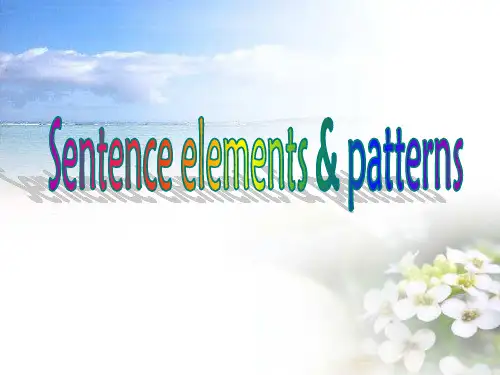
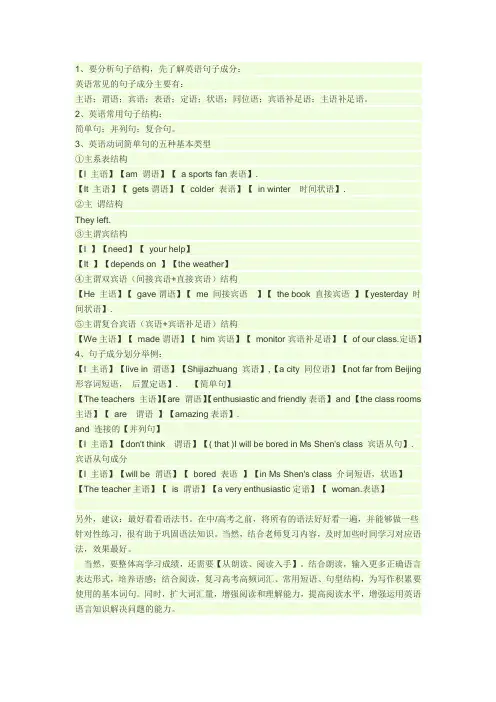
1、要分析句子结构,先了解英语句子成分:英语常见的句子成分主要有:主语;谓语;宾语;表语;定语;状语;同位语;宾语补足语;主语补足语。
2、英语常用句子结构:简单句;并列句;复合句。
3、英语动词简单句的五种基本类型①主系表结构【I 主语】【am 谓语】【a sports fan表语】.【It 主语】【gets谓语】【colder 表语】【in winter 时间状语】.②主谓结构They left.③主谓宾结构【I 】【need】【your help】【It 】【depends on 】【the weather】④主谓双宾语(间接宾语+直接宾语)结构【He 主语】【gave谓语】【me 间接宾语】【the book 直接宾语】【yesterday 时间状语】.⑤主谓复合宾语(宾语+宾语补足语)结构【We主语】【made谓语】【him宾语】【monitor宾语补足语】【of our class.定语】4、句子成分划分举例:【I 主语】【live in 谓语】【Shijiazhuang 宾语】,【a city 同位语】【not far from Beijing 形容词短语,后置定语】. 【简单句】【The teachers 主语】【are 谓语】【enthusiastic and friendly表语】and 【the class rooms 主语】【are 谓语】【amazing表语】.and 连接的【并列句】【I 主语】【don't think 谓语】【( that )I will be bored in Ms Shen's class 宾语从句】. 宾语从句成分【I 主语】【will be 谓语】【bored 表语】【in Ms Shen's class 介词短语,状语】【The teacher主语】【is 谓语】【a very enthusiastic定语】【woman.表语】另外,建议:最好看看语法书。
句子成份和简单句的五种基本句型第一课时教学重点:掌握句子成分和简单句的五种基本句型教学难点:怎样划分句子成分和辨别简单句的基本句型教学方法:理论讲解和举例相结合。
句子成份:一个句子的各个组成部分叫句子成份。
句子的成份有主语(S)、谓语(V)、表语(P)、宾语(O)、状语(Ad)定语(At)和宾语补足语(OC)等。
主语和谓语是句子的主要成份;而表语、宾语、状语、定语和宾语补足语则是句子的次要成份。
简单句:如果句子只包含一个主谓结构,而句子各个成分都只由单词或短语表示,就是简单句,不管句子是长是短。
e.gI like English.She comes from America.有时两个或更多的主语可以共一个谓语;两个或更多的谓语可以共一个主语;有时甚至可以有两个主语和两个谓语。
这样的句子仍然是简单句。
e.g1.Britain, America and Australia are English-speaking countries.2.They get coal out of the ground, change it into electricity, and send it to many places.3.Hank and his friends gave each other their addresses and promised to get in touch with each other.简单句的五种基本句型句型一:主语+不及物动词The pen writes well.S V AdOur class begins at seven o'clock.. S V AdThe earth goes around the sun.S V Ad不及物动词有:ache, appear, arrive, come, cough, disappear, fall, go等。
另外还有些既可作及物动词带宾语,也可作不及物动词不带宾语,如:break, burn, close, drop, fly, hurt, move, open, ring, shake, shut, understand等。
简单句的五种基本句型及句子成分一简单句的五种基本句型(1)主语+系动词+表语主系表结构Frank is clever/an architect.(2) 主语+不及物动词主谓结构My head aches.(3) 主语+及物动词+宾语主谓宾结构My sister enjoyed the play.(4)主语+及物动词+间接宾语+直接宾语主谓宾(双宾语)结构He gave Sam a watch. (5)主语+及物动词+宾语+宾补主谓宾结构They made Sam chairman/monitor.二系动词不及物动词及物动词(1) 系动词:be动词(在进行时或被动语态中除外)一些意思为变得的动词(turn become get go 等)感官动词(feel look smell taste notice sound等)总结:(2)不及物动词:后面不能跟宾语的动词。
总结:(3)及物动词:后面能跟宾语的动词。
注:三句子成分主语:任何句子都表明人或物做了什么动作或处于某种状态,其中的人或物为主语。
宾语:动词或介词后面不可缺少的名词或代词或其他名词性成分。
表语:系动词后面的成分。
定语:修饰名词或代词的成分。
状语:在句子里面表示动作发生的时间,地点,原因,目的,结果,方式,比较,让步,伴随,方式的成分。
补语:补充说明主语或宾语的成分。
(make let have get/ consider find call name/感官动词等) 同位语:解释说明名词或代词的成分。
四练习(1)认识简单句的基本句型。
(是主谓(宾)还是主系表)1.He works hard . 6.The baby is crying.2.To see is to believe. 7.The mouse was eaten by a cat.3.She felt happy at the party. 8.We found the film interesting.4.I teach the second grade. 9.They made me happy.5.He showed me the way to the post. 10.Electricity can make a machine run.(2标明下列句子的成分。
简单句的五种基本句型句型一主语+系动词+表语(SLP)[讲解] (1) 系动词的三种分类:在初中阶段,我们学过的表示“保持或状态”类的有be, remain, stay, keep, prove等;表示“变化”类的有grow, turn, get, become, fall, go, come等;表示“感官”类的有look, sound, smell, taste, feel, seem, appea r等。
例如:I am a senior school student while he is a junior one.我是高中生,他是初中生。
After four years, Tom became a doctor/ turned doctor.四年后,汤姆成了一名医生。
The story sounds interesting and instructive.这故事听起来既有趣,又有教育意义。
(2) 可以充当表语的有形容词、名词、副词(短语)、介词短语、表语从句、分词(短语)等。
例如:In order to keep healthy, he takes exercise everyday. (形容词作表语)In my mind, mother is my hero. (名词作表语)Look! Your pet dog is there. (副词作表语)The schoolbags come in different sizes. (介词短语作表语)You’ve changed a lot. You are not what you were. (表语从句作表语)Many passengers got injured in the accident. (过去分词作表语)The machine keeps running for a long time. (现在分词短语作表语)(3) 使用系动词应注意的地方:第一,没有被动语态;第二,一般没有进行时(除了feel以外);第三,有些动词既是系动词又是普通动词。
英语句子成分及简单句5种基本句型一、英语句子成分根据英语词汇在英语句子中的地位和作用, 英语句子的成分可分为主语、谓语、宾语、宾语补足语、表语、定语、状语、同位语及独立成分等。
其中,主语和谓语是句子的主要成分,一般情况下,一个句子不能缺少这两种成分。
现将不同句子成分的用法列举如下:1. 主语:表示句子所要说明或描述的人或事物,一般由名词、代词或相当于名词的词组或句子充当,置于句首。
如:It's getting cold. 天冷起来了。
Now everything is ready. 现在一切都准备好了。
The teacher is very kind to us. 老师对我们很好。
2. 谓语:说明或描述主语的动作、状态或特征,由动词或动词短语充当,位于主语之后。
如:Mother bought me a birthday present. 妈给我买了个生日礼物。
We have finished our work already. 我们已经完成了工作。
3. 表语:表示主语的身份、性质、状态和特征,一般由名词、形容词、或相当于名词、形容词的词、短语或句子充当,位于系动词之后,形成英语独有的主系表结构。
如:Be careful! 小心!All the students are lovely. 所有的学生都很可爱。
He looks very angry. 他看上去很生气。
4. 宾语:指动作所涉及的人或事物,一般由名词、代词或相当于名词的词组或句子充当,位于动词之后。
如:He wrote many plays. 他写了许多剧本。
She loves swimming. 她喜欢游泳。
5. 宾语补足语:用来对宾语进行补充和说明,一般由名词、形容词、副词、介词短语或非谓语动词充当。
如:He told us to stay. 他叫我们留下。
I've never seen her dancing. 我从未看见过她跳舞。
句子成分和简单句五个基本句型一、句子成分构成句子的各个部分叫做句子成分。
(一)主语主语是一个句子所叙述的主体,一般位于句首。
但在there be结构、疑问句(当主语不是疑问词时)和倒装句中,主语位于谓语、助动词或情态动词后面。
1.During the 1990s, American country music has become more and more popular.(名词)2.We often speak English in class.(代词)3.One-third of the students in this class are girls.(数词)4.To swim in the river is a great pleasure.(不定式)5.Smoking does harm to the health.(动名词)6.The rich should help the poor.(名词化的形容词)7. When we are going to have an English test has not been decided.(主语从句)8. It is necessary to master a foreign language.(it作形式主语,真正的主语为后面的不定式)(二)谓语谓语说明主语所做的动作或具有的特征和状态。
动词在句中作谓语,一般放在主语之后。
1、简单谓语:由一个动词或动词短语构成。
如:He practices running every morning.2、复合谓语:(1)由情态动词或其他助动词加动词原形构成。
You may keep the book for two weeks.He has caught a bad cold.(2)由系动词加表语构成。
如:We are students.(三)表语表语用以说明主语的身份、特征和状态,它一般位于系动词(如be, become, get, look, grow, turn, seem等)之后。
Our teacher of English is an American.(名词)Is it yours?(代词)The weather has turned cold.(形容词)The speech is exciting.(分词)Three times seven is twenty one?(数词)His job is to teach English.(不定式)His hobby is playing football.(动名词)The machine must be out of order.(介词短语)Time is up. The class is over.(副词)The truth is that he has never been abroad.(表语从句)(四)宾语宾语表示动作的对象或承爱者,一般位于及物动词和介词后面。
They went to see an exhibition yesterday.(名词)The heavy rain prevented me from coming to school on time.(代词)How many dictionaries do you have? I have five.(数词)They helped the old with their housework yesterday.(名词化形容词)He pretended not to see me.(不定式短语)I enjoy listening to popular music.(动名词短语)I think(that)he is fit for his office.(宾语从句)宾语种类:(1)双宾语(间接宾语+直接宾语),例如:Lend me your dictionary, please.(2)复合宾语(宾语+宾补),例如:They elected him their monitor.(五)宾语补足语(宾补)英语中有些及物动词,除有一个直接宾语以外,还要有一个宾语补语,才能使句子的意义完整。
带有宾语补足语的一般句型为:某些及物动词(如make等+宾语+宾补)。
His father named him Dongdong.(名词)They painted their boat white.(形容词)Let the fresh air in.(副词)You mustn’t force him to lend his money to you.(不定式短语)We saw her entering the room.(现在分词)We found everything in the lab in good order.(介词短语)We will soon make our city what your city is now.(从句)(六)定语修饰名词或代词的词、短语或从句称为定语。
Hangzhou is a beautiful city.(形容词)China is a developing country; America is a developed country.(分词)There are thirty women teachers in our school.(名词)His progress in English made us surprised.(代词)Our monitor is always the first to enter the classroom.(不定式短语)The teaching plan for next term has been worked out.(动名词)He is reading an article about how to learn English.(介词短语)(七)状语修饰动词、形容词、副词或整个句子,说明动作或状态特征的句子成分,叫做状语。
Light travels most quickly.(副词及副词性词组)He has lived in the city for ten years.(介词短语)He is proud to have passed the national college entrance examination.(不定式短语)He is in the room making a plane model.(分词短语)Wait a minute.(名词)Once you begin, you must continue.(状语从句)状语种类1. How about meeting again at six?(时间状语)2. Last night she didn’t go to the dance party because of the rain.(原因状语)3. I shall go there if it doesn’t rain.(条件状语)4. Mr Smith lives on the third floor.(地点状语)5. She put the eggs into the basket with great care.(方式状语)6. She came in with a dictionary in her hand.(伴随状语)7. In order to catch up with the others, I must work harder.(目的状语)8. He was so tired that he fell asleep immediately.(结果状语)9. She works very hard though she is old.(让步状语)10.I am taller than he is.(比较状语)(八)同位语一个名词(或其它形式)对另一个名词或代词进行修饰,限定或说明,这个名词(或其它形式)就是同位语。
同位语与被它限定的词的格要一致,并常常紧挨在一起。
Mr. Smith, our new teacher, is very kind to us.Yesterday I talked to my English teacher, Mr. James.He himself told me that his brother is a doctor.二、句子种类两种分类法1、按句子的用途可分四种:(1)陈述句(肯定、否定):He is six years old.She didn’t hear of you before.(2)疑问句(一般、特殊、选择、反意):Do they like skating?How old is he?Is he six or seven years old?Mary can swim, can’t she?(3)祈使句Be careful, boys; Don’t talk in class(4)感叹句How clever the boy is!按句子的结构可分三种:1)简单句:只有一个主语(或并列主语)和一个谓语(或并列谓语)。
He often reads English in the morning.Tom and Mike are American boys.She likes drawing and often draws pictures for the wallnewspapers.2) 并列句:由并列连词(and, but, or等)或分号(;)把两个或两个以上的简单句连在一起构成。
You help him and he helps you.The future is bright; the road is tortuous. 。
3)复合句:含有一个或一个以上从句的句子。
复合句包含:名词性从句、定语从句和状语从句等。
The foreign visitors took a lot of pictures when they were at the Great Wall.并列句的分类1、表示连接两个同等概念,常用and, not only…but also…,neither…nor…, then等连接。
The teacher’s name is Smith, and the student’s nam e is John.2、表示选择,常用的连词有or, either…or…, otherwise等。
Hurry up, or you’ll miss the train.3、表示转折,常用的连词有but, still, however, yet, while, when等。